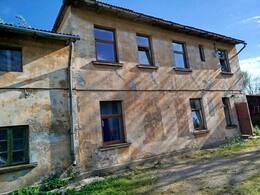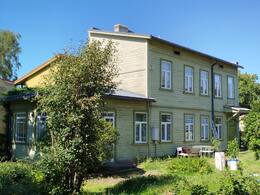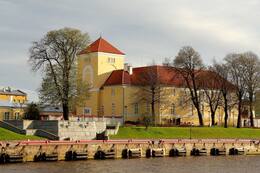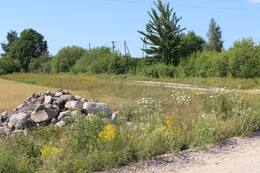Valentina Lasmanes erfolgreiche Flucht
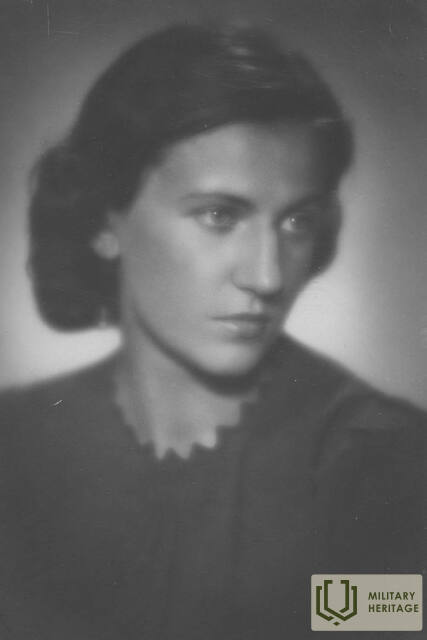
Eine biografische Erzählung von Valentīne Lasmane darüber, wie ihr die Flucht aus der Haft während der deutschen Besatzung gelang.
„Es kam die Nachricht, dass ich verhaftet werden sollte. Und dann sagte Ģinters zu mir: ‚Valentīns, du musst hier weg. Du kannst uns mit reinziehen, wenn du verhaftet wirst.‘ Ah, jetzt fing ich an nachzudenken. Ģinters hatte ein paar Leute beauftragt, meine Wohnung in der Laukustraße zu bewachen. Die Wohnung war in einem zweiten Haus im Hof. Das erste Haus stand an der Straße, dann kam ein Hof, dann das zweite Haus. Vor dem Haus war ein kleiner Garten. In diesem Garten hatten ein paar Leute Wache. Eines Abends, als ich nach Hause kam, bestellte ich Kartoffeln im Ofen. Und plötzlich stürmt Frišenfelds herein und sagt: ‚Nimm deine Sachen!‘ Ich schnappte mir meine Tasche, und er zerrte mich durch den Raum, riss das Fenster auf, mich hinaus und sich selbst – bumm! – nach draußen. Und da, in den Büschen, steckte ein Motorrad fest. Dann kletterte er auf das Motorrad und zerrte mich hinaus.“
Wir sind nicht nach Schweden gegangen, um Schweden zu werden / Zin. ed. B. Bela. Riga: Zinātne, 2010, S. 208.
Zugehörige Zeitleiste
Zugehörige Themen
Zugehörige Objekte
Das Gebäude in Ventspils, in dem der LCP-Verbindungsmann Valentine Jaunzeme (Lasmane) im Jahr 1944 wohnte.
Das Haus in der Lauku-Straße 4 in Ventspils war das Zuhause der Lehrerin Valentīne Lasmane (geb. Jaunzeme) (1916–2018). Sie war Verbindungsoffizierin der Lettischen Kommunistischen Partei und Mitglied der Verbindungsgruppe Ventspils. Nach dem Zweiten Weltkrieg lebte sie in Schweden.
Sie trug die Zeugnisse von 130 Bootsflüchtlingen in der Publikation „Über das Meer 1944/1945“ (Stockholm, 1990) zusammen, doch V. Lasmanes eigene Lebensgeschichte kann in dem Buch „Die Nacht ist nicht länger nur zum Schlafen da“ (Riga, 2020) nachgelesen werden. Im Jahr 2000 wurde ihr der Drei-Sterne-Orden verliehen. Sie starb 2018 im Alter von 102 Jahren im Stockholmer Vorort Täby.
Die Küste von Mazirbe, von wo aus 1944 der Flüchtlingsbootverkehr nach Schweden stattfand.
Die Küste von Mazirbe war während des Zweiten Weltkriegs ein wichtiger Ort, von dem aus 1944 Flüchtlingsboote nach Schweden gelangten.
Erinnerungen der Bootsflüchtling Ilona Cīrule (geb. Mālītis): „Ich war damals 13 Jahre alt. Ich erinnere mich, dass wir Ende September eine ganze Woche lang in einem Wohnwagen von Riga nach Mazirbe reisten. Die Reise ist mir als etwas Unangenehmes in Erinnerung geblieben: Die russischen Kerzen am Himmel beunruhigten mich zutiefst. Wir lebten etwa drei Wochen in Mazirbe, und jeden Tag hörte ich Gespräche über die Überfahrt und die Suche nach Booten. Schließlich, am 21. Oktober, mussten wir uns bereit machen. […] Wir waren etwa 90 Personen auf dem Boot. Ich saß auf dem Schoß meines Vaters an Deck. Die kleinen Kinder mit ihren Müttern waren unten und bekamen kaum Luft. Ich muss wohl eingenickt sein, aber am Morgen des nächsten Tages wurde ein Flugzeug gesichtet und ein Schiff am Horizont. Da wurde es still. Am Nachmittag kam das Schiff wieder, und diesmal kam es direkt auf uns zu. Aber es geschah wie im Märchen: Es war ein schwedisches Kriegsschiff! Sie zogen uns alle an Bord.“ Das Schiff gab uns warmen Kakao und brachte uns zum Hafen von Nynäshamn. Unser Boot wurde dort festgemacht und von seinem Besitzer, Zariņš-Petravs, wohlbehalten in Empfang genommen. Unter den Gästen waren Šici, Zanderi, Vanagi, die ehemalige Justizministerin Frau Apsīša, unsere Familie und andere. Ich weiß, dass das Boot mit Gold bezahlt werden musste. Aber wie viel – das weiß ich nicht.
Das Gebäude in Ventspils, in dem Dr. Valdemārs Ģinters, ein Vertreter der lettischen Kommunistischen Partei und Organisator des Flüchtlingsbootverkehrs in Kurzeme, in den Jahren 1944-1945 lebte.
Das Haus in der Katrīnes-Straße 4, Ventspils, in dem der Archäologe Valdemārs Ģinters arbeitete.
Von Oktober 1944 bis zum 8. Mai 1945 war der Archäologe Valdemārs Ģinters (Spitznamen „Doktor“, „Gärtner“) (1899–1979) Vertreter der Lettischen Kommunistischen Partei Lettlands (LCP) in Kurzeme. Er nahm am Lettischen Unabhängigkeitskrieg teil, war Direktor des Staatlichen Historischen Museums und Dozent an der Universität Lettlands. Ihm wurden der Lāčplēsis-Kriegsorden und der Drei-Sterne-Orden verliehen. Er war einer der Unterzeichner des LCP-Memorandums vom 17. März 1944. Nach dem Zweiten Weltkrieg lebte er in Schweden. Von 1949 bis 1979 war er Vorsitzender des Vorstands der Lettischen Nationalstiftung.
Gefängnis in der Burg des Livländischen Ordens während des Zweiten Weltkriegs
Mehrere Mitglieder der Kommunikationsgruppe LCP Ventspils und Flüchtlingsbootsbetreiber wurden 1944-1945 in dem im Schloss des Livländischen Ordens eingerichteten Gefängnis inhaftiert.
Erinnerungen des Bootsmanns Žanis Fonzovs: „Zwei Boote verließen Schweden – die „Krīvs“ und die „Zvejnieks“. Ich war auf der „Zvejnieks“, und zur Besatzung gehörten Saulīte und Grunti. […] Das Wetter war herrlich, ich segelte so unauffällig, nicht sehr hoch. Ich sah es sofort – ich war im Morsecode. Das Boot näherte sich. Ich ging hinunter in den Maschinenraum, denn neben Saulītes Papieren hatte ich auch Briefe von den Ankünften an Verwandte in Lettland und die gesammelten Waffen in einer Tasche. Ich warf die Briefe und Papiere in diese Waffentasche und alles über Bord. Was dann! Das Boot näherte sich unserem, und die Deutschen verlangten unsere Führerscheine. […] So brachten uns die Deutschen am 21. Oktober mit der gesamten „Zvejnieks“ nach Ventspils. Sie brachten uns ins Gefängnis. Es waren etwa 30 Leute in dem Raum. Ich trug einen Schaffellmantel.“ Zurück auf dem Boden legte ich es mir über, aber ich hatte die Nacht nicht geschlafen. Am zweiten oder dritten Tag wurden wir zum Verhör vorgeladen. Wir hatten vereinbart, zu sagen, dass wir Flüchtlinge auf dem Weg nach Deutschland seien. Ich wollte nur nach Lielirbe, um meinem Freund zu folgen. Anscheinend glaubten sie uns damals. […] Doch dann änderte sich die Lage in Ventspils: Die Stadt wurde von der Militärverwaltung übernommen, und wir wurden ein zweites Mal verhört. Es war schlimmer, denn sie zeigten uns eine Schachtel schwedischer Streichhölzer und eine Krone, die angeblich auf dem Boot gefunden worden waren. Einer der Vernehmer war Lette, und er enthauptete uns sogar, weil wir die ganze Wahrheit gesagt hatten. Wir sahen ein, dass das Märchen vorbei war; wir mussten einfach gestehen.
Der Weg zum Haus "Grīnieki" in der Gemeinde Vārve
Die Straße zu den Häusern „Grīnieki“ in der Gemeinde Vārve, wo sich 1944 eine der wichtigsten Siedlungen für Bootsflüchtlinge an der Küste Kurlandes befand.
Erinnerungen des Bootsmanns V. Jurjakas: „Als ich den Hof von „Grīnieki“ betrat, wirkte alles ganz normal. Ein ruhiges Landhaus, keine Menschenseele, wahrscheinlich nur Leute in der Sonne. […] Es stellte sich heraus, dass nicht nur das Wohnhaus von „Grīnieki“ voll belegt war, sondern alle Gebäude. Die Scheune, der Getreidespeicher, der Heuboden und das Badehaus. Ich traf ein paar Bekannte, denn es war Zeit, unser Land zu verlassen. […] Die Ernährungslage war nicht kritisch, aber doch recht schlecht. […] Am Abend setzte sich der Flüchtlingstreck in Richtung Küste in Bewegung. Ich hatte alle im Voraus gewarnt, nicht aus dem Gebüsch am Strand herauszukommen, da sich dort Unterstände und Beobachtungsposten der Küstenwache befanden. Es war ein großer Treck, denn etwa 200 Menschen wollten ans Meer. Es bestand keine Hoffnung, dass alle rechtzeitig ankommen würden. Der Abend war noch nicht sehr dunkel, und ich konnte die Aktivitäten der gesamten Gruppe beobachten. Am auffälligsten waren die großen „Als die Menschen noch lebten“-Konvois.“ In „Grīnieki“ hatten sie sie nicht gesehen, doch jetzt, im Licht der Öffentlichkeit, sahen sie nur noch dies. Allein die Waren benötigten ein ganzes Boot. Drei bis vier zweispännige Wagen waren mit Waren beladen, gefolgt von den Menschen. […] Wir warteten lange auf das Boot, aber es kam nicht. Die ganze Karawane musste umkehren. Es war stockdunkel.
Temporäre Flüchtlingsunterkünfte „Vārves būda“
"Vārves būdas", ein Ort in der Gemeinde Ventspils, der 1944 als vorübergehende Unterkunft für lettische Flüchtlinge diente, die auf die Ankunft von Booten aus Gotland warteten.
Erinnerungen des Bootsmanns V. Jurjaks:
Mein Halbbruder und seine Familie waren aus Riga zu uns gekommen, und als die Nachricht kam, dass in Vārve ein Schiff erwartet wurde, schloss ich mich mit der Gruppe um Polizeichef Jasūnas zusammen, und wir machten uns alle auf den Weg nach Vārve. Wir warteten bis spät in die Nacht auf Signale, aber das Schiff kam nicht. So warteten wir eine ganze Woche. Es begann zu regnen. Die Leute bauten Zelte aus Laken, deshalb nannten wir diesen Ort „Vārve-Hütten“. Meine Frau und ich verbrachten tagsüber mehr Zeit in Ventspils, und schließlich mussten wir uns überlegen, wie wir die Wartenden mit Essen versorgen konnten. Ich erinnere mich an eine Nacht, als meine Frau und ich ihnen auf unseren Fahrrädern heiße, gekochte Kartoffeln durch den Wald brachten. Es regnete in Strömen, Blitze zuckten, und die warmen Kartoffeln schmeckten den Wartenden, die sich aus dem Wald gedrängt hatten, gut. Der Förster von Vārve hatte dieses Versteck zufällig entdeckt, aber – nachdem ich ihm eine Versetzung in Aussicht gestellt hatte – kam er, um zu helfen. Die Deutschen hatten begonnen, durch das Gebiet zu gehen. Die Häuser der Küstenbewohner wurden durchsucht, um Menschen aus den Jahren der Wehrpflicht zu finden. Zwei junge Leute waren im Wald nahe der „Vārve-Hütten“ aufgegriffen worden. Daher konnte dieser Ort für die über fünfzig Menschen, die hier ausharrten, nicht mehr sicher sein.





